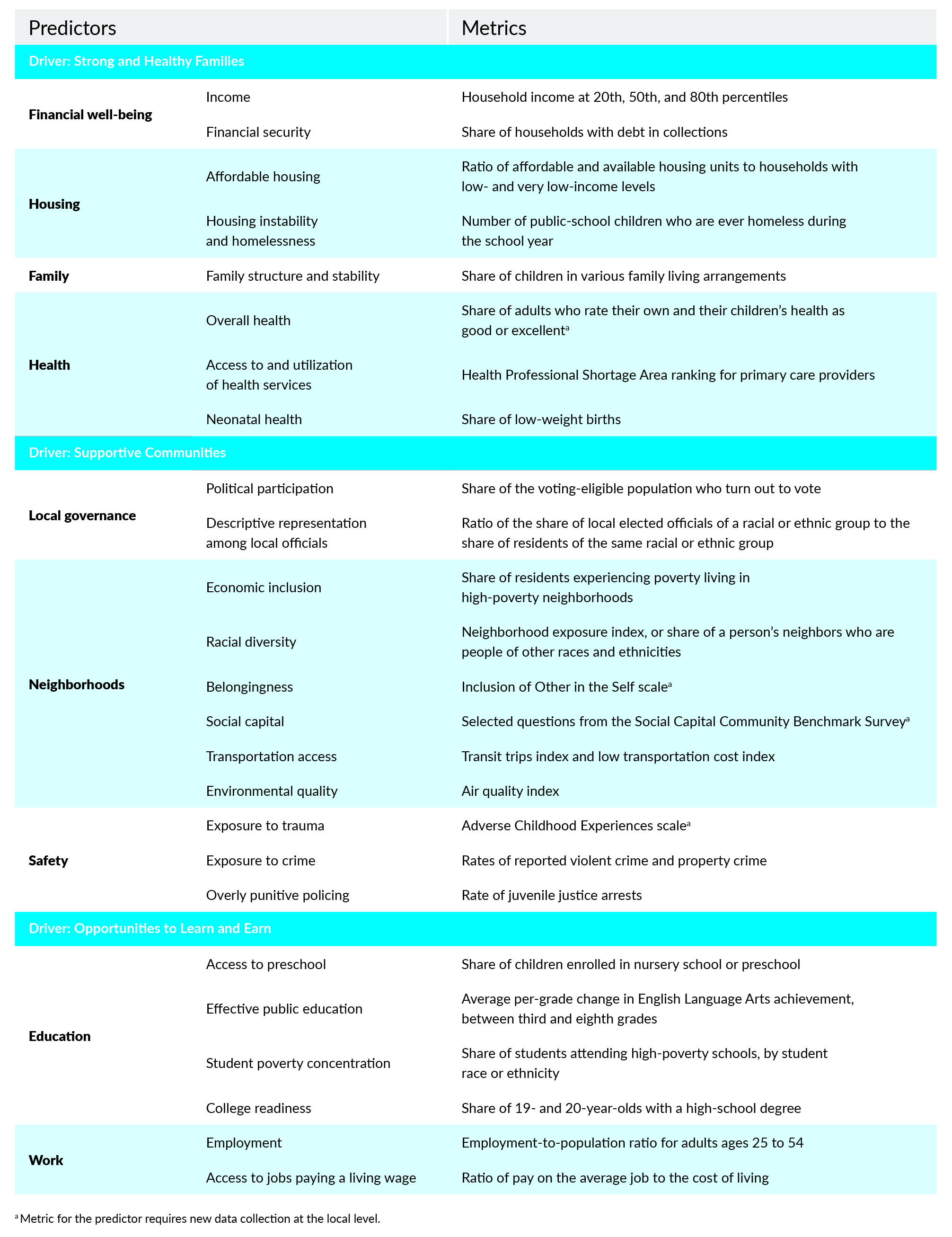Revised, May 24, 2022
Local leaders need to know whether their programs and policies to curb racial inequities and help residents experiencing poverty are making a difference. Tracking their progress on such endeavors requires recognizing the conditions that influence people’s ability to experience upward mobility and how to measure them. But what does that look like?
As part of the Urban Institute’s work to boost upward mobility from poverty, our experts developed a framework to help local governments understand and improve the dimensions and drivers of upward mobility in their communities. The framework features a suite of predictors, or key community factors, that influence mobility from poverty. Assessments documenting the relationship between each predictor and upward mobility can be found in our Evidence Resource Library. The predictors selected for the framework are paired with metrics local policymakers can use to monitor upward mobility and inform policy decisions.
To design the framework, Urban convened a working group to determine the 25 strongest predictive factors in a community that influence upward mobility. Together, the selected predictors reflect all three dimensions of mobility from poverty, which are people’s ability to achieve economic success, feel valued in their community, and have a sense of power and autonomy over their lives. These predictors were chosen in part because:
- they cover different policy domains (e.g., education, work, housing, health);
- they influence various stages of life (e.g., early childhood, adolescence, transition to adulthood, adulthood);
- they can be affected by state and local policy changes; and
- they highlight structural barriers that make it harder for people to exit poverty. These include historic and current structural racism, discrimination, and disinvestment in people and communities of color.
Accompanying each predictor is an associated metric, most of which were determined using publicly available data. Many of these metrics can be disaggregated by race and ethnicity and measured at multiple geographic levels. Below, we summarize the metrics we selected to help communities assess where they stand on influencing the key predictors of upward mobility.

Communities can use these metrics to track their progress on influencing mobility from poverty through the following:
- comparing their progress to neighboring communities’ and building public support for tackling mobility
- prioritizing where they need to focus their attention to have the greatest impact on upward mobility
- spotlighting how predictive factors that influence upward mobility intersect with multiple policy domains to identify the different roles local and state changemakers can play
- setting targets for advancing upward mobility and racial equity as part of local and state investments, policies, and practices
- assessing their progress over time and holding local stakeholders accountable
Our Upward Mobility Cohort of eight counties is actively testing these mobility metrics to determine whether they are applicable and relevant to their local challenges. Urban calculated mobility metrics data for these counties, which are accessible by clicking on the county’s name on the Cohort Counties page. As part of Urban’s technical assistance process, we are also working with the counties to complement these data with other local sources and community members’ insights. Over time, through collecting each county’s feedback on the metrics and getting input from our working group and other experts, we will refine the suite of metrics.
Learn more: You can dive into detailed explanations about each predictor of upward mobility and its associated metrics in our Boosting Upward Mobility: Metrics to Inform Local Action report. Also check out a discussion of the methodology in determining the predictors and metrics, including criteria on which the metrics were evaluated. The methodology page also provides more detail on our Evidence Resource Library.